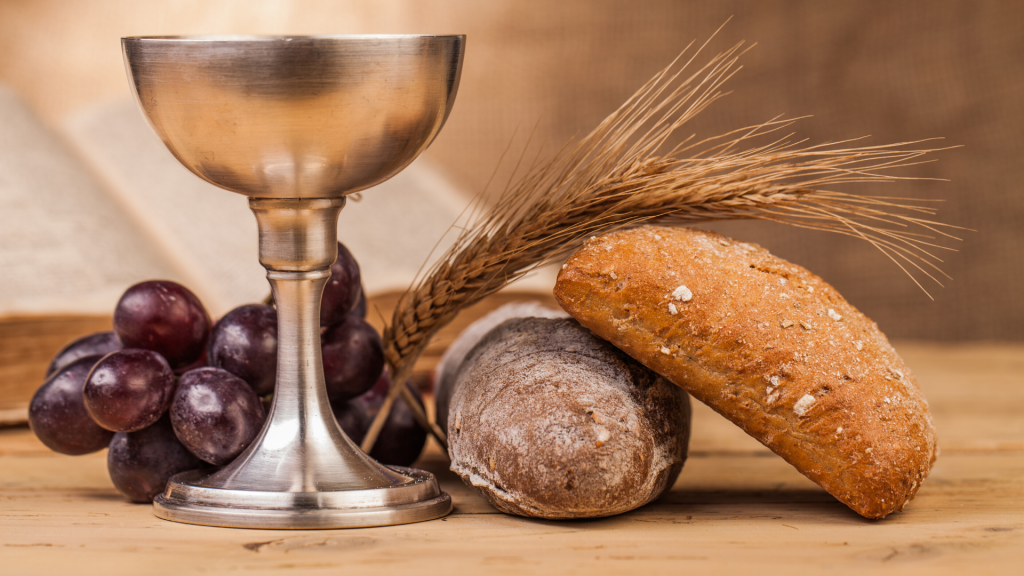Sermon by:
The Rev. Ernie Lewis
Proverbs 9:1-6
Ephesians 5: 15-20
John 6:51-58
August 18, 2024
In recent weeks, we’ve heard about Jesus’s teaching by the lakeside culminating in the feeding of five thousand from five loaves of bread and two dried fish brought that day by a small boy as his lunch.
We’ve heard about the clambering of that crowd to haul Jesus off to be made king and his withdrawal from them.
Now we come upon him again the next day on the other side of the lake and he continues his teaching.
And this is where the “trouble” begins!
“I am the living bread that came down from heaven. Whoever eats of this bread will live forever; and the bread that I will give for the life of the world is my flesh,” he says, and, ”Very truly, I tell you, unless you eat the flesh of the Son of Man and drink his blood, you have no life in you.” And, “Those who eat my flesh and drink my blood abide in me and I in them.”
Here, we need to turn aside for a minute!
We do not know the exact identity of the John who penned this gospel. We do know that it was written many years after the three synoptic gospels, Mathew Mark and Luke. We also believe it was written to a community of believers who had gathered around John, the so called “Johnine Community”. They had become very close knit, maybe something like what we would call, without the negative connotation, a “clique” or “gang”.
The suggestion of eating human flesh and drinking blood would have been abhorrent to Jews, even those who had begun to believe that Jesus might be the promised Messiah!
It’s likely members of that “Johnine clique”, perhaps because of suspicion in the culture around them that they were subversive, developed a kind of “special language” or “slang” as is often the case in closely knit groups such as gangs or special interest groups. These attempt to disguise activities unlawful or unacceptable in the surrounding community. Examples in our time might be things such as “packing heat” for carrying a gun, or “dissin’ for being disrespectful. Linguists have suggested these words be called “antilanguage”.
Members of the Johnine Community would have known what Jesus meant by his words. They understood the language of their community. He was talking about taking in to their bodies, into their very inner beings, his claims to be that “Word” which was “in the beginning,” which “was with God”, and was “in the beginning with God,” and who “became flesh” and “lived among (them)”!
Members of that community were comfortable with these words of “antilanguage”. They knew what was meant by the words spoken.
Bruce Malina and Richard Rohrbaugh have noted: “In terms of antilanguage, to ingest Jesus’ flesh and blood is synonymous with welcoming, accepting, receiving, believing in, and the like. Blood is the seat of life. It is through ingesting Jesus’ flesh and blood, through accepting and welcoming Jesus as the Word become Israelite human, crucified as ‘King of the Judeans’ that those who believe in Jesus have their life as children of God.”[1]
But it was, and is, not always so clearly understood. Many of Jesus’s hearers simply couldn’t get past the horror of the words taken at face value: the accusation of cannibalism! We’re told that “conflicts arose among them and because of this many of his disciples turned back and no longer went about with him.”
So, how is it with us?
Theologians through the centuries have constructed big words to describe the nature of the elements taken at communion in the Eucharist, words like “transubstantiation”, “consubstantiation,” and “real presence”. or simply “remembrances”. This is neither the time nor the place for that discussion. Committed, humble followers of Jesus can and do subscribe to one or the other of these.
So.
What it all comes down to is this:
We hold out our hands and receive bread and wine.
We hear the words:
“The Body of Christ, the bread of heaven.”
“The Blood of Christ, the cup of salvation.”
That’s perhaps the most important thing we can do. Those elements are real, tangible, see-able, touch-able, and taste-able.
They are the physically identifiable evidence of what was accomplished for us by God through Jesus’ life, his death and his resurrection. It is up to us to simply and humbly receive them; to take them into our bodies.
Do I “welcome, accept, receive, believe and the like”?
Do you?
Do we?
As we come to this table this morning and hold out our hands to receive the elements and hear those familiar words, let us pray simply that we may receive them and “feed on him in our hearts with thanksgiving.”
Amen!
[1] Malina, B.J., Rohrbaugh R.L. “Social Science Commentary on the Gospel of John” Fortress Press1998,p135

